Preparation and Self-Healing Properties of Clinker/PVP Microsphere in Cement Paste
Abstract
1. Introduction
2. Materials and Methods
2.1. Materials
2.2. Preparation of clinker/PVP Microsphere
2.3. Mix Proportion and Specimen Preparation
2.4. Test Procedure
2.4.1. Morphology of Microsphere
2.4.2. Chemical Structure of Microsphere
2.4.3. Coating Film Thickness
2.4.4. Autolytic Behavior
2.4.5. Strength Recovery and Damage Degree of Self-Healing Specimens
3. Results
3.1. Characterization of Clinker/PVP Microsphere
3.1.1. Morphology and Microstructure Analysis
3.1.2. Coating Film Thickness and Size Distribution
3.1.3. Autolytic Behavior Analysis
3.2. Self-Healing Effectiveness of Specimen with Microsphere Prepared
3.2.1. Recovery of Compressive Strength
3.2.2. Recovery of Damage Degree
4. Conclusions
- The clinker/PVP autolytic microsphere is successfully prepared, and the self-healing potential is confirmed via the chemical structure measured by FTIR.
- The film coating thickness increases first and then decreases with the increasing usage of coating materials, since there exists the optimal viscosity of solution. The maximum film thickness was 7.54 μm in the PVP/clinker ratio of 4%.
- The autolytic behavior of the clinker/PVP autolytic microsphere is successfully controlled by pretreatment degree (i.e., silane coupling agent amount).
- The self-healing potential of specimens with autolytic microspheres improves with an increase in the microsphere amount.
- The self-healing effectiveness of clinker/PVP autolytic microspheres is confirmed by the compressive strength recovery and damage degree tests.
Author Contributions
Funding
Conflicts of Interest
References
- Wang, X.F.; Yang, Z.H.; Fang, C.; Han, N.X.; Zhu, G.M.; Tang, J.N.; Xing, F. Evaluation of the mechanical performance recovery of self-healing cementitious materials—Its methods and future development: A review. Constr. Build. Mater. 2019, 212, 400–421. [Google Scholar] [CrossRef]
- Das, A.K.; Mishra, D.K.; Yu, J.; Leung, C.K.Y. Smart Self-Healing and Self-Sensing Cementitious Composites—Recent Developments, Challenges, and Prospects. Adv. Civ. Eng. Mater. 2019, 20190023, 1–25. [Google Scholar] [CrossRef]
- Van Breugel, K. Self-healing material concepts as solution for aging infrastructure. In Proceedings of the 37th Conference on Our World in Concrete & Structures, Singapore, 29–31 August 2012. [Google Scholar]
- Van Tittelboom, K.; De Belie, N. Self-healing in cementitious materials-a review. Materials. 2013, 6, 2182–2217. [Google Scholar] [CrossRef] [PubMed]
- Huang, H.; Ye, G.; Qian, C.; Schlangen, E. Self-healing in cementitious materials: Materials, methods and service conditions. Mater. Des. 2016, 92, 499–511. [Google Scholar] [CrossRef]
- Sangadji, S. Can Self-healing Mechanism Helps Concrete Structures Sustainable? Procedia Eng. 2017, 171, 238–249. [Google Scholar] [CrossRef]
- Li, C.; Wu, M.; Chen, Q.; Jiang, Z. Chemical and mineralogical alterations of concrete subjected to chemical attacks in complex underground tunnel environments during 20–36 years. Cem. Concr. Compos. 2018, 86, 139–159. [Google Scholar] [CrossRef]
- Murakami, T.; Ahn, T.H.; Hashimoto, T.; Ogura, N.; Kishi, T. A study on the new water leak repair method for subway tunnels using crack self-healing repair materials. J. Ceram. Process. Res. 2015, 16, 95–97. [Google Scholar]
- Li, V.C.; Herbert, E. Robust Self-Healing Concrete for Sustainable Infrastructure. J. Adv. Concr. Technol. 2012, 10, 207–218. [Google Scholar] [CrossRef]
- He, J.; Shi, X. Developing an abiotic capsule-based self-healing system for cementitious materials: The state of knowledge. Constr. Build. Mater. 2017, 156, 1096–1113. [Google Scholar] [CrossRef]
- Ren, Q.; Zeng, Z.; Jiang, Z.; Li, H. Functionalization of renewable bamboo charcoal to improve indoor environment quality in a sustainable way. J. Clean. Prod. 2020, 246C, 119028. [Google Scholar] [CrossRef]
- Maes, M.; Snoeck, D.; De Belie, N. Chloride penetration in cracked mortar and the influence of autogenous crack healing. Constr. Build. Mater. 2016, 115, 114–124. [Google Scholar] [CrossRef]
- Van Mullem, T.; Gruyaert, E.; Debbaut, B.; Caspeele, R.; De Belie, N. Novel active crack width control technique to reduce the variation on water permeability results for self-healing concrete. Constr. Build. Mater. 2019, 203, 541–551. [Google Scholar] [CrossRef]
- Van Breugel, K. Is there a market for self-healing cement-based materials? In Proceedings of the First International Conference on Self Healing Materials, Noordwijk aan Zee, The Netherlands, 18–20 April 2007. [Google Scholar]
- Yıldırım, G.; Khiavi, A.H.; Yeşilmen, S.; Şahmaran, M. Self-healing performance of aged cementitious composites. Cem. Concr. Compos. 2018, 87, 172–186. [Google Scholar] [CrossRef]
- Wu, M.; Johannesson, B.; Geiker, M. A review: Self-healing in cementitious materials and engineered cementitious composite as a self-healing material. Constr. Build. Mater. 2012, 28, 571–583. [Google Scholar] [CrossRef]
- Tang, W.; Kardani, O.; Cui, H. Robust evaluation of self-healing efficiency in cementitious materials—A review. Constr. Build. Mater. 2015, 81, 233–247. [Google Scholar] [CrossRef]
- Schlangen, E.; Sangadji, S. Addressing infrastructure durability and sustainability by self healing mechanisms—Recent advances in self healing concrete and asphalt. Procedia Eng. 2013, 54, 39–57. [Google Scholar] [CrossRef]
- Li, W.; Dong, B.; Yang, Z.; Xu, J.; Chen, Q.; Li, H.; Xing, F.; Jiang, Z. Recent advances in intrinsic self-healing cementitious materials. Adv. Mater. 2018, 1705679, 1–9. [Google Scholar] [CrossRef]
- Li, W.; Zhu, X.; Zhao, N.; Jiang, Z. Preparation and properties of melamine urea-formaldehyde microcapsules for self-healing of cementitious materials. Materials 2016, 9, 152–168. [Google Scholar] [CrossRef]
- Li, W.; Jiang, Z.; Yang, Z. Acoustic characterization of damage and healing of microencapsulation-based self-healing cement matrices. Cem. Concr. Compos. 2017, 84, 48–61. [Google Scholar] [CrossRef]
- Li, C.; Zhu, H.; Wu, M.; Wu, K.; Jiang, Z. Pozzolanic reaction of fly ash modified by fluidized bed reactor-vapor deposition. Cem. Concr. Res. 2017, 92, 98–109. [Google Scholar] [CrossRef]
- Jiang, Z.; Li, W.; Yuan, Z. Influence of mineral additives and environmental conditions on the self-healing capabilities of cementitious materials. Cem. Concr. Compos. 2015, 57, 116–127. [Google Scholar] [CrossRef]
- Dong, B.; Wang, Y.; Fang, G.; Han, N.; Xing, F.; Lu, Y. Smart releasing behavior of a chemical self-healing microcapsule in the stimulated concrete pore solution. Cem. Concr. Compos. 2015, 56, 46–50. [Google Scholar] [CrossRef]
- Jiang, Z.; Li, J.; Li, W. Preparation and characterization of autolytic mineral microsphere for self-healing cementitious materials. Cem. Concr. Compos. 2019, 103, 112–120. [Google Scholar] [CrossRef]
- Lee, Y.S.; Ryou, J.S. Self healing behavior for crack closing of expansive agent via granulation/film coating method. Constr. Build. Mater. 2014, 71, 188–193. [Google Scholar] [CrossRef]
- Liu, W.; Roos, Y.H.; Fan, F. Physicochemical properties and relaxation time in strength analysis of amorphous poly (vinyl-pyrrolidone) and maltodextrin: Effects of water, molecular weight, and lactose addition. J. Food Eng. 2018, 226, 82–95. [Google Scholar] [CrossRef]
- Naghdi Sedeh, N.; Entezam, M.; Hassan Jafari, S.; Khonakdar, H.A.; Abdouss, M. Morphology, drug release behavior, thermal, and mechanical properties of poly(ethylene oxide) (PEO)/poly(vinyl pyrrolidone) (PVP) blends. J. Appl. Polym. Sci. 2018, 135, 1–9. [Google Scholar] [CrossRef]
- Malhotra, B.; Keshwani, A.; Kharkwal, H. Natural polymer based cling films for food packaging. Int. J. Pharm. Pharm. Sci. 2015, 7, 10–18. [Google Scholar]
- Princigallo, A. Elastic and self-healing properties of concrete including graded clinker. ACI Mater. J. 2018, 115, 761–768. [Google Scholar] [CrossRef]
- Zhong, W.; Yao, W. Influence of damage degree on self-healing of concrete. Constr. Build. Mater. 2008, 22, 1137–1142. [Google Scholar] [CrossRef]
- Wang, P.; Feng, S.; Liu, X. Application of Backscattered Electron Imaging and Image Analysis in Microstructure Research on Cement-Based Materials. J. Chinese Silic. Soc. 2011, 39, 1659–1665. [Google Scholar]
- Wu, C.; Mosher, B.P.; Lyons, K.; Zeng, T. Reducing ability and mechanism for polyvinylpyrrolidone (PVP) in silver nanoparticles synthesis. J. Nanosci. Nanotechnol. 2010, 10, 2342–2347. [Google Scholar] [CrossRef] [PubMed]
- Usman, R.; Mihata, A.; Kurawaki, J. Rapid synthesis and characterization of polyvinylpyrrolidone-protected silver nanoparticles by heating method. e-Journal Surf. Sci. Nanotechnol. 2015, 13, 431–434. [Google Scholar] [CrossRef]
- Stoch, A.; Zdaniewicz, M.; Paluszkiewicz, C. The effect of polymethylsiloxanes on hydration of clinker phases. J. Mol. Struct. 1999, 511–512, 319–325. [Google Scholar] [CrossRef]
- Alghamri, R.; Kanellopoulos, A.; Al-Tabbaa, A. Impregnation and encapsulation of lightweight aggregates for self-healing concrete. Constr. Build. Mater. 2016, 124, 910–921. [Google Scholar] [CrossRef]
- Xu, J.; Yao, W. Multiscale mechanical quantification of self-healing concrete incorporating non-ureolytic bacteria-based healing agent. Cem. Concr. Res. 2014, 64, 1–10. [Google Scholar] [CrossRef]

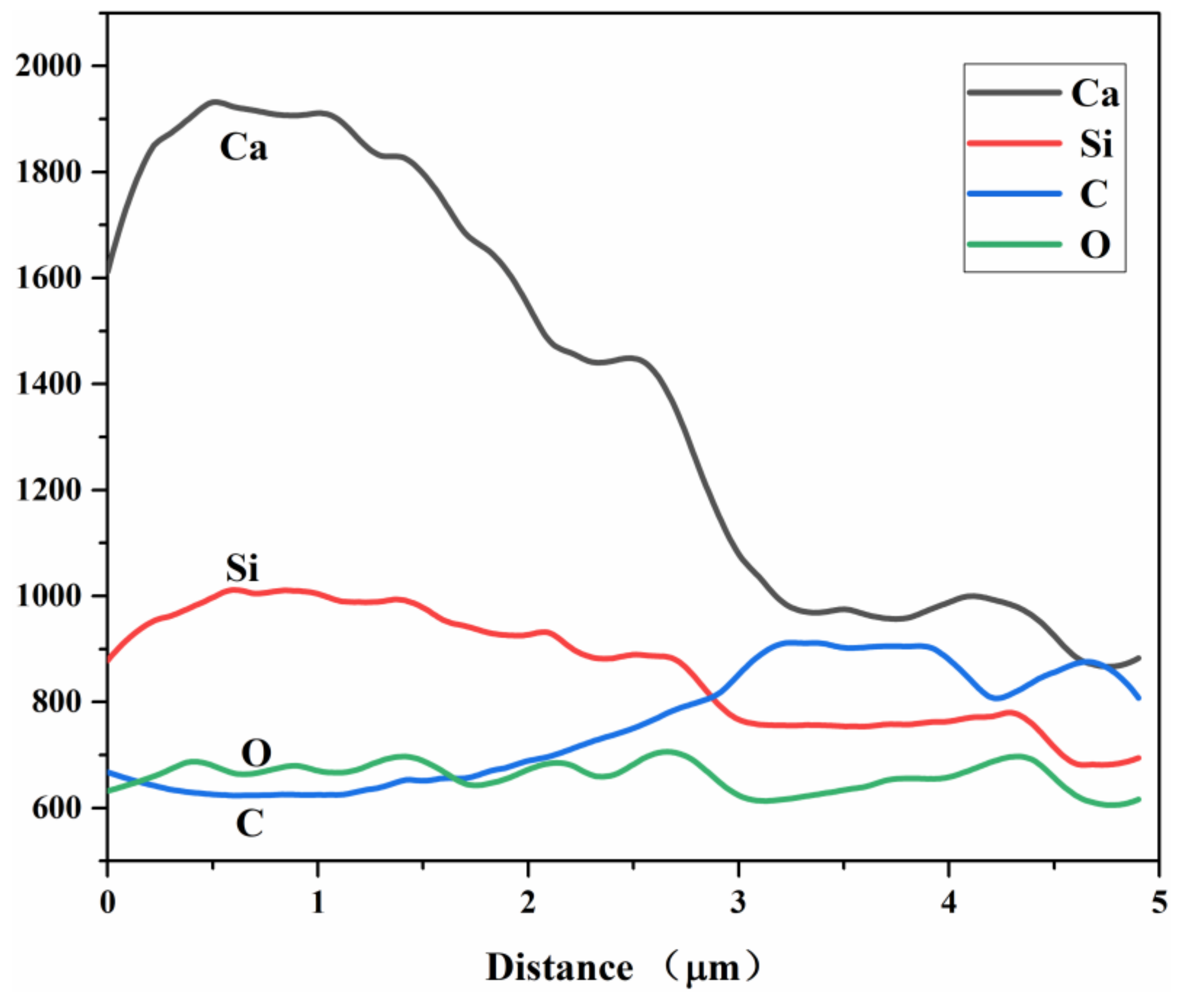
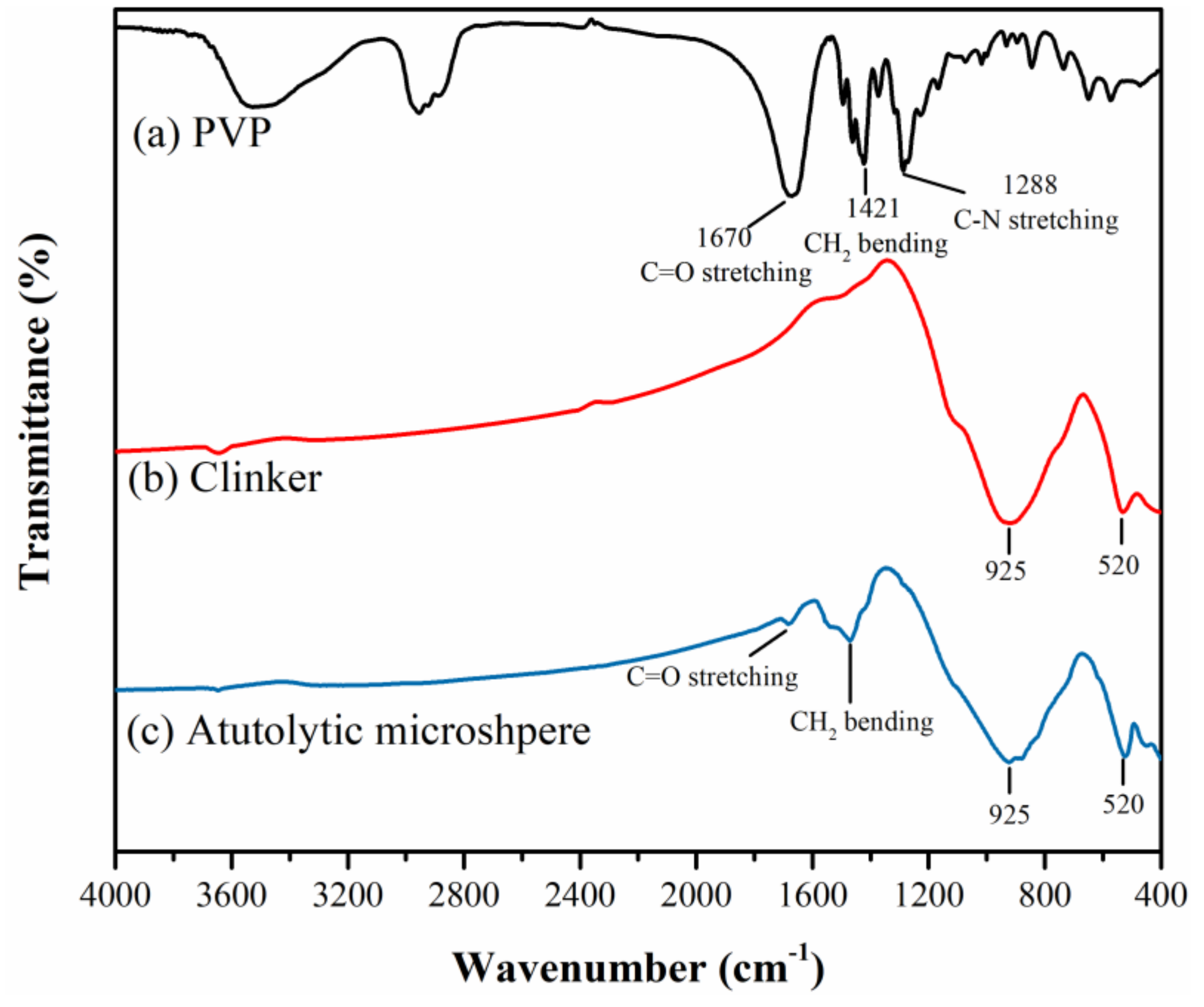
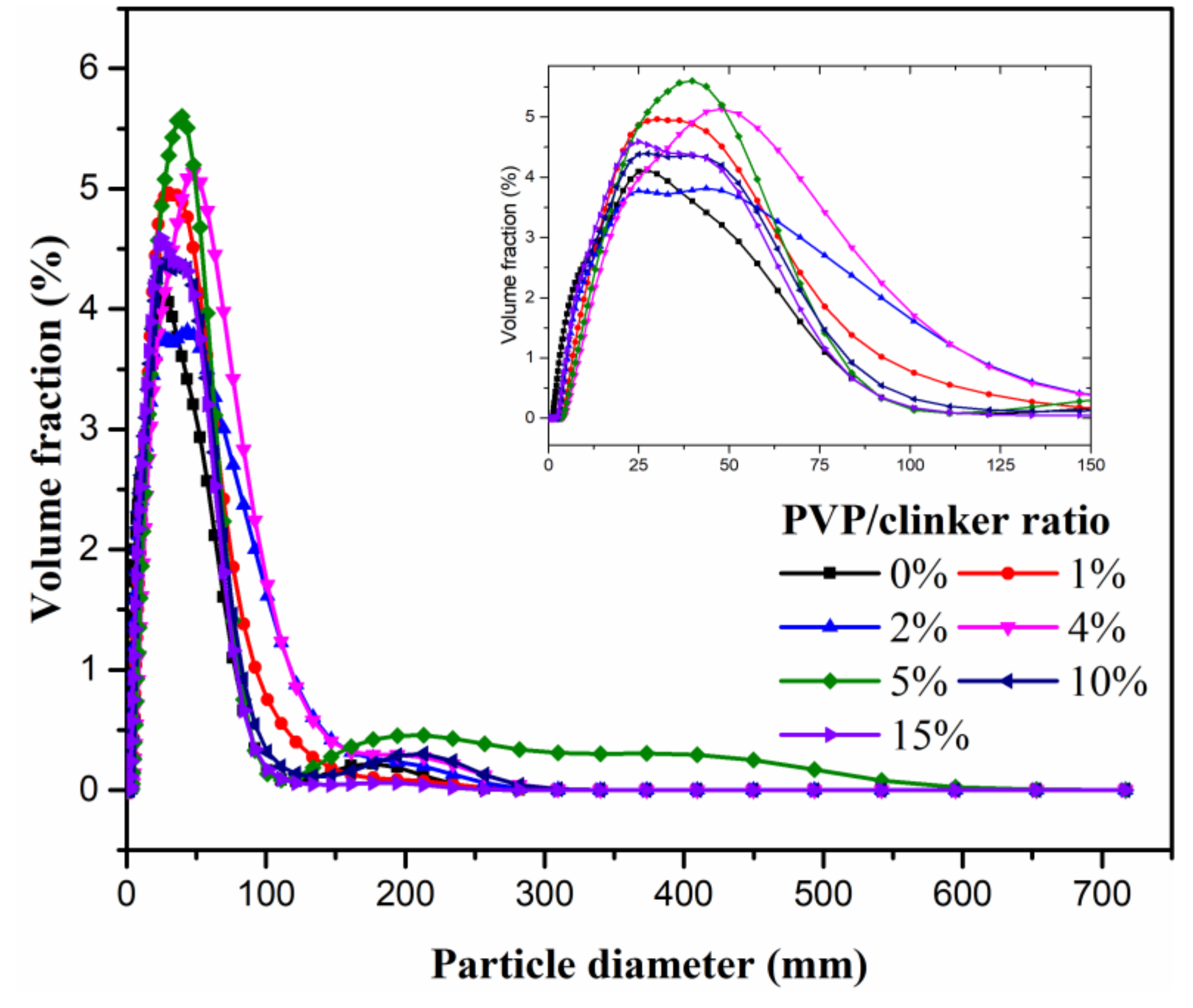

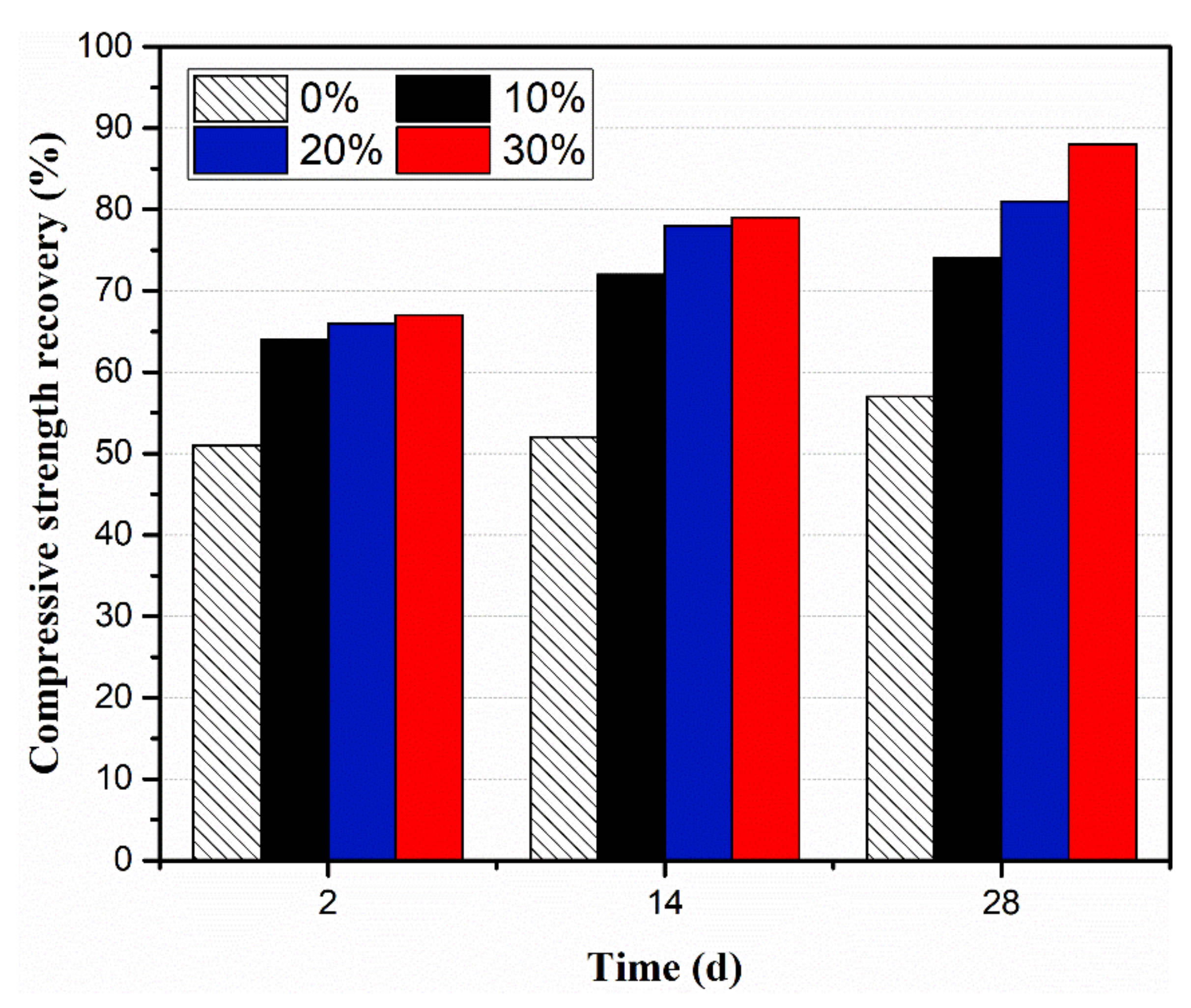
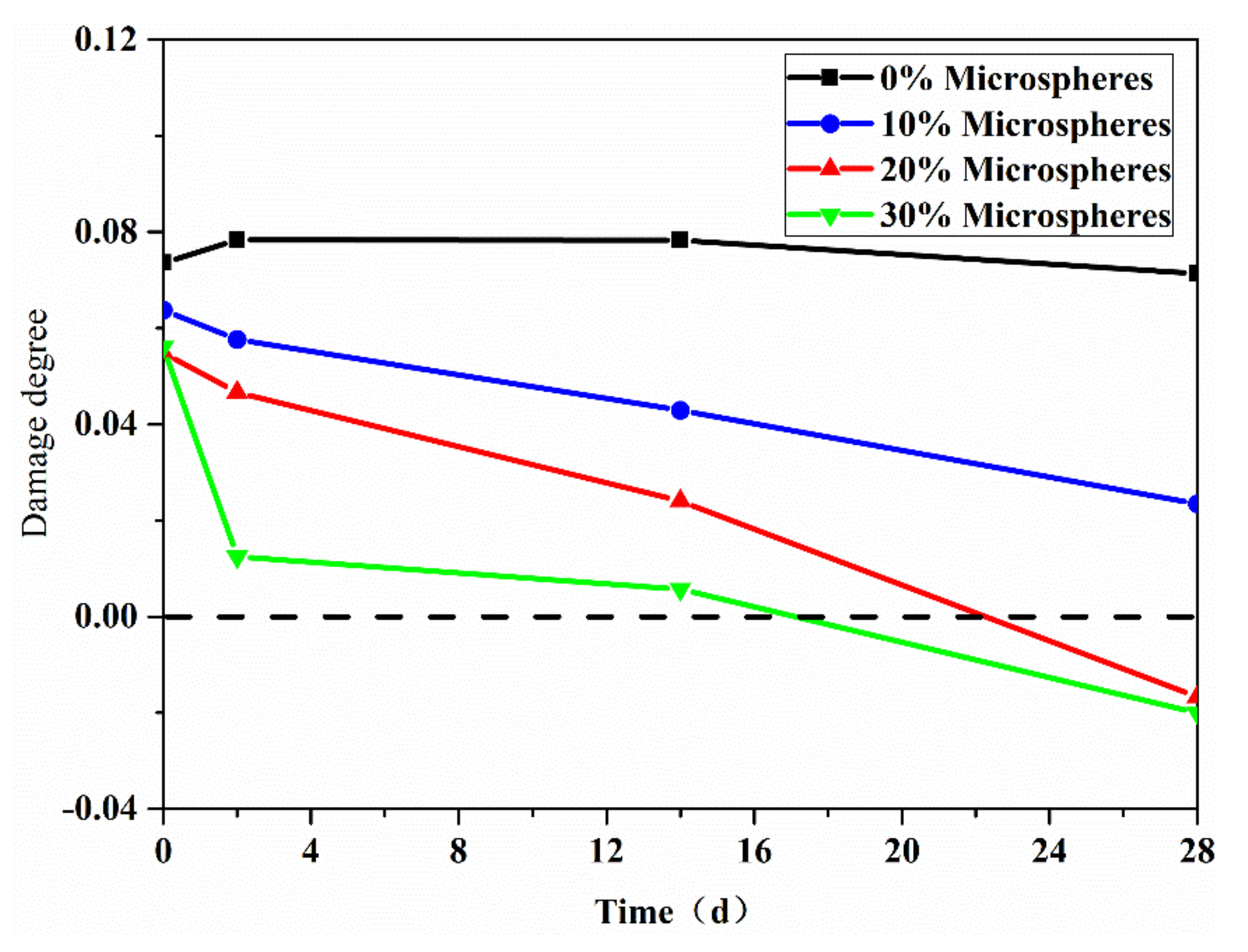
| CaO | SiO2 | Fe2O3 | Al2O3 | MgO | SO3 | Na2O | K2O | Other |
|---|---|---|---|---|---|---|---|---|
| 63.1 | 24.1 | 3.27 | 4.34 | 1.16 | 0.76 | 0.12 | 0.8 | 2.35 |
| Description | No. 1 | No. 2 | No. 3 | No. 4 | No. 5 | No. 6 | No. 7 |
|---|---|---|---|---|---|---|---|
| PVP/clinker ratio | 0% | 1% | 2% | 4% | 5% | 10% | 15% |
| Component | SiO2 | Al2O3 | Fe2O3 | CaO | MgO | TiO2 | SO3 | Na2O | K2O | LOI |
|---|---|---|---|---|---|---|---|---|---|---|
| Content (wt.%) | 20.0 | 4.51 | 3.11 | 64.3 | 0.68 | 0.22 | 2.99 | 0.03 | 0.72 | 2.70 |
| Description | w/c | Microsphere Fraction (wt. % with Cement) | Specimens Number | Test Method |
|---|---|---|---|---|
| Compression | 0.35 | 0 | 3 | For ultimate resistance |
| 0.35 | 10 | 3 | ||
| 0.35 | 20 | 3 | ||
| 0.35 | 30 | 3 | ||
| Pre-compression | 0.35 | 0 | 9 | For strength recovery and pulse test |
| 0.35 | 10 | 9 | ||
| 0.35 | 20 | 9 | ||
| 0.35 | 30 | 9 |
| Element Weight % | Ca | Si | C | O |
|---|---|---|---|---|
| Point 1 | 37.01 | 8.44 | 11.43 | 43.12 |
| Point 2 | 17.07 | 4.12 | 45.08 | 33.14 |
| Point 3 | 9.69 | 2.34 | 62.27 | 25.07 |
| Description | No. 1 | No. 2 | No. 3 | No. 4 | No. 5 | No. 6 | No. 7 |
|---|---|---|---|---|---|---|---|
| PVP/clinker ratio | 0% | 1% | 2% | 4% | 5% | 10% | 15% |
| Mean diameter (μm) | 21.05 | 27.20 | 27.50 | 36.12 | 32.54 | 26.16 | 24.62 |
| Average film thickness (μm) | 0 | 3.08 | 3.23 | 7.54 | 5.75 | 2.56 | 1.79 |
© 2020 by the authors. Licensee MDPI, Basel, Switzerland. This article is an open access article distributed under the terms and conditions of the Creative Commons Attribution (CC BY) license (http://creativecommons.org/licenses/by/4.0/).
Share and Cite
Li, J.; Jiang, Z.; Li, W. Preparation and Self-Healing Properties of Clinker/PVP Microsphere in Cement Paste. Materials 2020, 13, 589. https://doi.org/10.3390/ma13030589
Li J, Jiang Z, Li W. Preparation and Self-Healing Properties of Clinker/PVP Microsphere in Cement Paste. Materials. 2020; 13(3):589. https://doi.org/10.3390/ma13030589
Chicago/Turabian StyleLi, Jun, Zhengwu Jiang, and Wenting Li. 2020. "Preparation and Self-Healing Properties of Clinker/PVP Microsphere in Cement Paste" Materials 13, no. 3: 589. https://doi.org/10.3390/ma13030589
APA StyleLi, J., Jiang, Z., & Li, W. (2020). Preparation and Self-Healing Properties of Clinker/PVP Microsphere in Cement Paste. Materials, 13(3), 589. https://doi.org/10.3390/ma13030589





